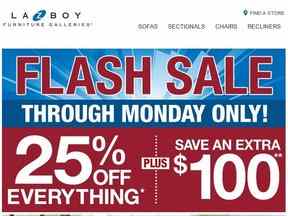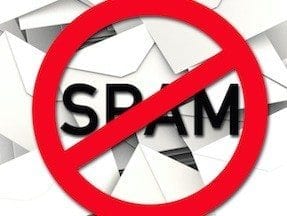The sender name and subject line are primary drivers of email open rates. Almost as important — if not more important — is the pre-header, the text that appears just below the subject line in the inbox of most mobile and desktop email clients.
In this post, I’ll offer five pre-header tips, to encourage your recipients to open your emails.
1. Avoid Repeated Words
There is no need to repeat the “From” text in either the subject line or the pre-header. And there’s also no need to repeat subject line text in the pre-header.

This sender — Chrysler Dodge Jeep Ram Seattle — repeats its name in the subject line (in blue), wasting space that could be used for something meaningful.
This may seem obvious. However, I frequently receive emails that have repeated content in the subject line, the “From” line, and the pre-header text. Recipients see your company or brand name in the From line. There is no reason to repeat that in the subject line or in the pre-header. In addition, many senders simply repeat their subject line or a variation of the subject line in the pre-header. Again, that is redundant and a waste of valuable real estate.
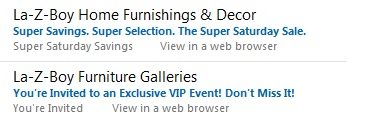
La-Z-Boy has many repeated words in the subject lines (in blue) and pre-headers.
The example above, from La-Z-Boy, has two errors. First, there are repeated words from the subject line to the pre-header. In the first email, La-Z-Boy the word “Super” is used four times, “Savings” two times, and “Saturday” two times. It’s too much to read and comprehend when presented so close together.
In the other email example, La-Z-Boy repeats the exact first two words — “You’re Invited” — of the subject line again in the pre-header, thus wasting the opportunity to tell subscribers something different that may prompt them to open the message.
The second error from the La-Z-Boy examples is using a “View in web browser’ link.” These links were used as best practices years ago for email clients that did not render content well. Few, if any, people need or click on these links now, in 2016.
If a sender believes it should keep the “View in web browser” link, the sender should move the link down so it does not display in the inbox preview, as the recipient cannot do anything with that information until after she opens the email. It’s best to use that space to tell the recipient something new that will entice her to actually open the email.
2. Pre-headers Are Extensions of Subject Lines
Writing subject lines is difficult. The objective is to get recipients interested so they will open the email. Fortunately, pre-headers help with this. As an extension of the subject line, pre-headers allow senders to convey more information, including an entirely different topic or promotional copy, to really encourage opens. This is how Discovery Senior Living uses its pre-headers, as shown below.

This pre-header — “Discover. Connect. Experience. Get your free guide to…” — extends from the subject line and raises the curiosity of the recipient, which can increase opens.
In the example above, the pre-header — “Discover. Connect. Experience. Get your free guide to…” — nicely extends the subject line. The sentence breaks at a point — “Get your free guide to…’ — that prompts a reader’s curiosity, causing him to open. Having pre-headers purposely end at a point that requires the recipient to open for the additional information is a good way to increase opens.
3. Supplement Product Offers and Sales
If your company’s emails typically feature offers or sales, consider using pre-headers to showcase content. Pre-headers can have more characters than the subject line, which provides the opportunity to feature content in a compelling way.
Both examples below are from clothing retailers. Both use the pre-header to offer fashion tips, instead of pushing a sale.
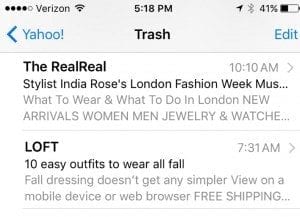
The RealReal and LOFT, two clothing retailers, use the pre-header to offer fashion tips, instead of pushing a sale. For The RealReal, it’s “What to Wear & What to Do in London.” For LOFT, it’s “Fall dressing doesn’t get any simpler.”
4. Try Capitalized Letters
Using all caps in a subject line can hurt deliverability. All caps can flag an email, increase its spam score, and cause the message to be filtered into a bulk or junk folder. However, using all caps or partial caps in a pre-header can be effective, especially since pre-headers display directly below the subject lines on smartphones.
In the example below, Ticketmaster uses a mostly-caps pre-header to emphasize the live event — “NOTHING BEATS BEING THERE!” — for the concert it is promoting.
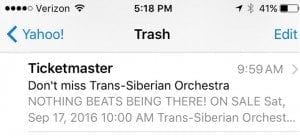
Using all caps in a subject line is a bad idea. But caps in a pre-header can be effective, as shown in this example from Ticketmaster — “NOTHING BEATS BEING THERE!.”
5. Use the Pre-header Real Estate
Perhaps you have not used pre-headers, or are unsure of crafting a clever one. Regardless, always take advantage of the pre-header real estate.
The example below show two emails from car dealerships. One used a pre-header (“Carolyn, The wait is finally over!”). The other did not.
The screenshot below is from my desktop inbox. Note the whitespace that is blank under the subject line from Rush Chevrolet. In the Phillips Chrysler email, the pre-header is an extension of the subject line. Moreover, Phillips Chrysler personalized the pre-header to include my name, which is even more effective.

The Rush Chevrolet email does not include a pre-header, which results in unnecessary whitespace. In the Phillips Chrysler email, the pre-header is an extension of the subject line. It’s also personalized, which is even more effective.


